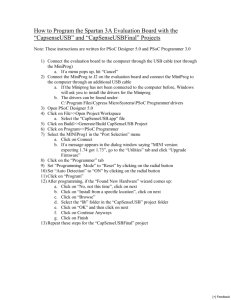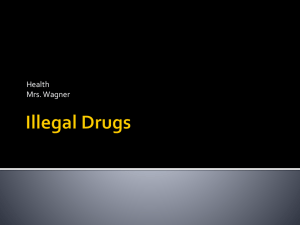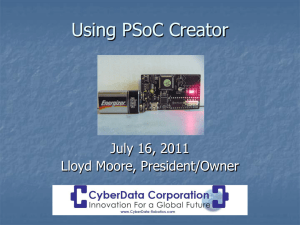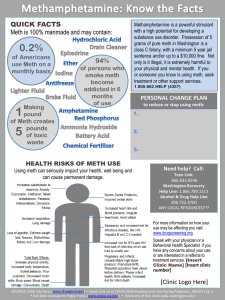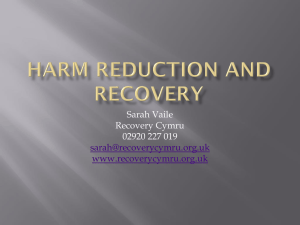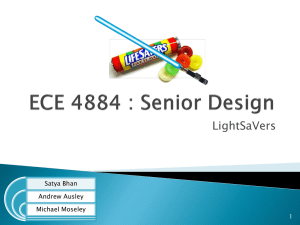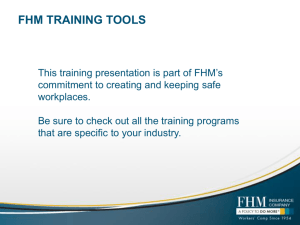Open slides - CTN Dissemination Library
advertisement
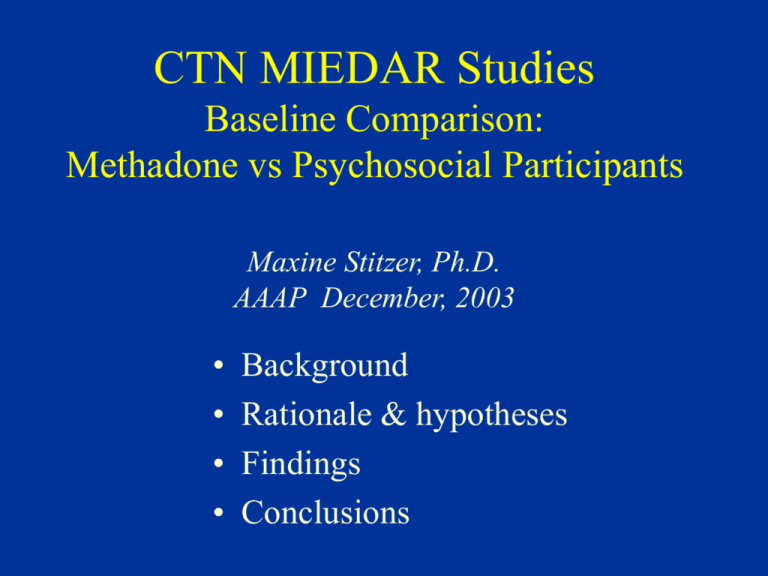
CTN MIEDAR Studies Baseline Comparison: Methadone vs Psychosocial Participants Maxine Stitzer, Ph.D. AAAP December, 2003 • • • • Background Rationale & hypotheses Findings Conclusions Drugs are Positive Reinforcers They Make People Feel Good. The Problem: Allure of Immediate Drug Reinforcement Drug Abusers Straddle the Fence Methods are needed to: Continued Drug Use Drug Abstinence - counteract ambivalence - increase motivation for change Motivational Incentives Offer tangible incentives for drug abstinence Make abstinence a more attractive option through positive reinforcement of behavior change Incentive Therapies Promote Abstinence Cocaine (Higgins et al., 1994; Silverman et al., 1996; Petry & Martin, 2002) Alcohol (Petry et al., 2000) Opioids (Bickel et al., 1997; Silverman et al., 1996) Marijuana (Budney et al., 1991, Budney et al., 2000) Nicotine (Tobacco smoking) (Stitzer & Bigelow, 1984; Roll et al., 1996) Problem: Cost • Society can’t afford this • Our program can’t afford this Intermittent Reward Reduces Cost Nancy Petry’s “Fishbowl” • Drug-free patient draws from the “fishbowl” • Only 50% of draws are “winners” • Three types of prizes: - small (toiletries; food) - large (cordless phone; CD player) - jumbo (TV; video) CTN MIEDAR Protocol: How Does It Work? Eligible Patients Stimulant Abusers either cocaine or methamphetamine Random Assignment • Usual care • Enhanced care with incentives Sample Collection Twice Weekly Abstinence Bowl Good Job Small Small Large Small Good Job Good Job Good Job Good Job Good Job Good Job Small Good Job Examples of Incentive Prizes SMALL ($1-$5 items) LARGE ($20 items) JUMBO ($80-$100 items) Draws Escalate with Stimulant-Free Test Results 5 4 3 2 1 Weeks Drug Free # Draws Bonus Draws for Marijuana and/or Opiate Abstinence 2 2 2 2 Weeks Drug Free 2 # Draws Total Earnings • $400 in prizes could be earned on average – If participant tested negative for all targeted drugs over 12 consecutive weeks Two MIEDAR Study Samples • Psychosocial (8 clinics; N = 415) – New admissions – Self-reported stimulant use within past 2 weeks (74%) or within 2 weeks of entering a controlled environment (23%) • Methadone (6 clinics; N = 388) – In treatment 1-36 months – Stimulant positive urine within past 2 weeks Baseline Comparison: Why Do IT? • Unique opportunity to characterize stimulant abusers entering different modalities • Results may suggest differential service needs Baseline Comparison: Methods • Data derived from selected questions in study intake interview • Areas of interest: – Demographics – Psychosocial characteristics (employment, education, etc) – Health problems(medical & psychiatric) – Drug use (stimulants, opiates, alcohol, cannabis) Hypotheses • Some patient characteristics may differ due to differential referral patterns (e.g. criminal justice) • Methadone patients will generally have more severe psychosocial and drug use problems due to their history of concurrent opiate and stimulant abuse Basic Demographics METH (N = 388) PSOC (N = 415) P value Gender (% male) 56 45 <.01 Race (% Caucasian) 26 36 <.01 Age (mean years) 42 36 <.01 Subsequent analyses adjusted for gender, race & age Psychosocial Characteristics METH PSOC P value Education (mean years) Marital Status (% married) 12 14 12 24 0.42 <.01 Employed- past 3 years (%) Employed- past 30 days (%) 50 32 68 35 <.01 0.74 Legal Status METH PSOC OR† CJ referral (%) 6 33 0.1 Parole/Probation (%) 16 35 0.3 † OR is methadone vs drug-free Health Problems METH PSOC OR Chronic med probs (%) Lifetime hospital (%) 59 80 38 67 1.8 1.8 Psychiatric hospital (%) Psychiatric outpatient (%) 29 37 29 35 Lifetime psych meds(%) 42 40 Drug Use: Stimulants PSOC OR 82 84 ___ 76 26 7.8 METH Dependence/Abuse (% with diagnosis) First Study Urine (% positive) Drug Use: Opiates METH PSOC OR Dependence/Abuse (% with diagnosis) 80 9 48 First Study Urine (% positive) 47 3 30 Drug Use: Alcohol Dependence/Abuse (% with diagnosis) METH PSOC OR 17 42 0.3 1 1 __ First Study BAL (% positive) Drug Use: Cannabis Dependence/Abuse (% with diagnosis) First Study Urine (% positive) METH PSOC OR 8 21 0.5 12 11 __ Drug Use: Other ASI past 30 days; % with any use SEDATIVES NICOTINE METH PSOC METH PSOC 25 6 91 79 Data Summary • Stimulant abusers entering methadone are: – Older – Less likely to have work history – More likely to have medical problems – More likely to be using opiates, stimulants & sedatives – Less likely to be alcohol or cannabis dependent Data Summary • Both groups have: – Substantial unemployment – Substantial psychiatric co-morbidity – High rates of medical problems – High rates of nicotine use – Modest rates of cannabis use Limitations • • • • Data apply only to stimulant abusers Clinics may or may not be representative Methadone have been in treatment longer Methadone are pre-selected for opiate abuse Conclusions: Service Needs • Common service needs suggested: – Employment; co-occurring medical & psychiatric – Shift in emphasis from cannabis to nicotine • Differential service needs suggested: – Effective interventions for on-going polydrug (opiate, stimulant and sedative) use in methadone – Relapse prevention in outpatient psychosocial Conclusions: CTN Potential • CTN is a great place to collect data on large samples of community treatment patients • Access to special patient subgroups of interest to service providers
